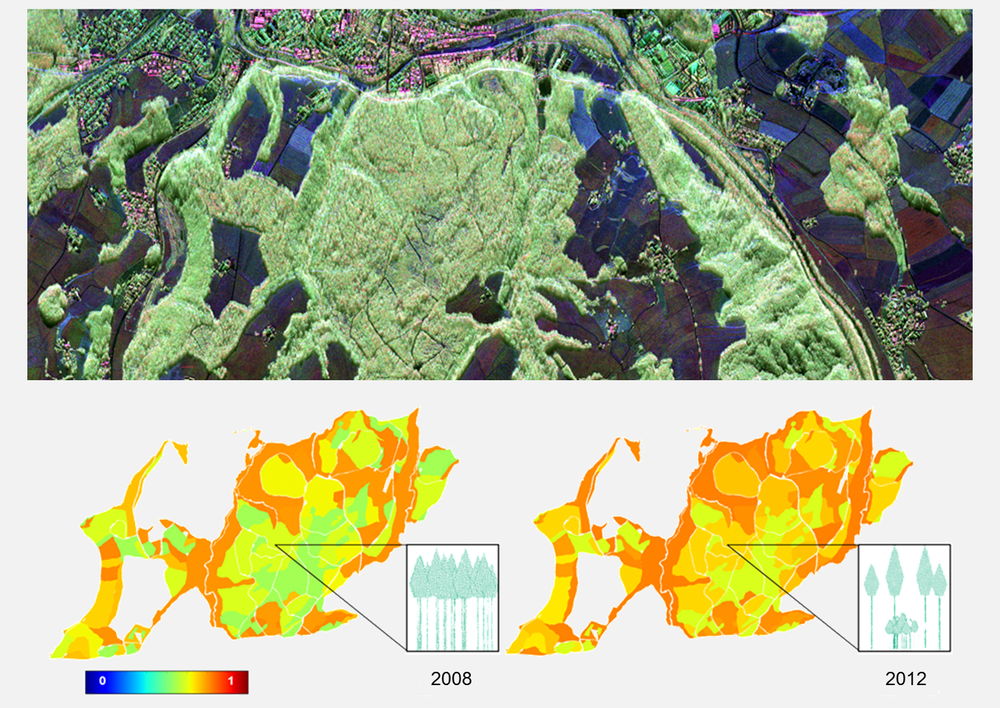Information Retrieval
The Information Retrieval group focuses on the development, implementation and validation of new algorithms and techniques for the generation of new higher-level information products in the context of actual and future spaceborne radar missions. The group includes leading expertise in SAR polarimetry (Pol-SAR), SAR interferometry (InSAR), polarimetric interferometry (Pol-InSAR) and SAR tomography (TomoSAR) in data calibration, handling, processing, inversion and validation techniques. It has unique experience in the parameterization, implementation and interpretation of SAR inversion algorithms that support the retrieval of physical parameters from airborne and spaceborne SAR data, and in the planning and evaluation of airborne and spaceborne SAR experiments. The broad expertise and experience of the group enables a wide spectrum of activities. A central task is the development of innovative modelling and inversion algorithms and processing techniques for the generation of new information products from multi-parameter SAR measurements. The definition and implementation of the associated performance analysis models is a second core activity of the group. Of the same importance is the development of innovative techniques and methods for the calibration of conventional and complex SAR operation modes and data sets of future SAR missions. The Information Retrieval group leads and contributes to several national and international studies and is active in the science and science advisory teams of national, European and international (as DLR’s TanDEM-X and Tandem-L, ESA’s BIOMASS, JAXA’s ALOS, NASA’s GEDI) missions and mission proposals.
Key projects and activities:
BIOMASS
BIOMASS is ESA's seventh Earth Explorer Mission aiming to map the spatial distribution and the temporal changes of forest biomass for the first time in a consistent way globally. Secondary mission objectives are in the mapping of arid areas, the estimation of the flow velocity of (fast) glaciers and the investigation of the internal structure of ice volumes. From the very beginning, the group was significantly involved in all mission phases of the BIOMASS activities with important science and technical contributions. It is responsible for the definition, generation and validation of the forest height product by means of model based inversion of three Pol-InSAR acquisitions. Of the same importance for BIOMASS are the contributions to the polarimetric and ionospheric calibration of the BIOMASS data.
GEDI – TanDEM-X Fusion
The Global Ecosystem Dynamics Investigation (GEDI) Lidar Mission is a NASA mission for global forest and forest biomass mapping. GEDI is implemented by means of a lidar instrument and operated on the board of the ISS from December 2018. The planned mission duration is 2 years. The group is part of the GEDI Science Team and responsible for the combination of GEDI and TanDEM-X data regarding improved vegetation products. The aim is to achieve the first global scale fusion of lidar with interferometric SAR data. This task includes the developmet, implementation, validation and finally global application of a methodology to use TanDEM-X data to interpolate forest biomass between GEDI tracks which are 500 m apart. This should improve the spatial resolution of the GEDI forest biomass maps. The resulting forest biomass map is recognized as an important missing contribution in the national and international scientific field and will become enormously important as a reference for future missions.
Tandem-L
Tandem-L is a proposal for a highly innovative spaceborne SAR mission for the global observation of dynamic processes on the earth’s surface. The group is actively involved from the very beginning, back in 2007, in the development of the mission proposal contributing to the definition of the mission concept, leading the development of multi-baseline interferometric and/or polarimetric processing and inversion techniques, developing innovative concepts for the calibration of the interferometric and/or polarimetric Tandem-L modi (with emphasis on the ionospheric calibration) and supporting the assessment of mission performance.
ALOS-PalSAR
Since 2004 the group is involved in the science, calibration and validation activities of the radar instruments (PalSAR 1, 2 and 3) of JAXA’s ALOS missions (1, 2 and 4). The group is part of the international science team of JAXA’s Kyoto & Carbon (K&C) Initiative and member of JAXA’s Calibration & Validation group. The Kyoto & Carbon (K&C) Initiative aims to support data and information needs raised by international environmental Conventions, Carbon Cycle Science and Conserva-tion of the environment (CCCs). The group is leading the scientific activities on Polarimetric SAR Interferometry (Pol-InSAR) techniques and coordinating the Forest Height Map Product, i.e. the demonstration of pre-operational forest height mapping. In the frame of the Calibration & Validation activities the group contributes with the development of generic calibration schemes for the calibration of polarimetric and/or interferometric data sets. The exploitation of the entirety of the ionosphere signature induced on a given observation space allows the development of combined calibration techniques with an improved performance in terms of accuracy and/or stability.

